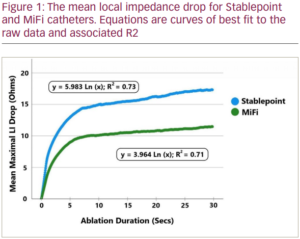Background: Local impedance (LI) drop is a novel parameter that correlates with ablation lesion size in preclinical studies. Values for LI drop that establish effective pulmonary vein isolation were established in the LOCALIZE trial using the IntellaNav MiFi catheter. However, a new contact force sensing catheter (IntellaNav Stablepoint [SP]) has recently come to market and is likely to supplant the MiFi catheter. Effective clinical values for LI drop for the SP catheter are not established. Objective: To compare the biophysical response of the MiFi and SP catheters during atrial fibrillation (AF) ablation; to establish a conversion factor for LI drop between catheters.
Methods: Patients undergoing AF ablation were recruited. Radiofrequency ablation occurred at sites across both left and right atria and always included pulmonary vein isolation. Ablation settings (power, duration, contact force [SP only]) were determined by the operator. LI was measured throughout each ablation and exported for further analysis. LI was sampled at 20 Hz and the filtered value generated by the Rhythmia system used for analysis. LI drop was calculated as the difference between the measured LI and that at the start of ablation. The relationship between LI drop and ablation duration for both catheters was mathematically modelled and compared. In addition, to establish a time frame whereby ablation resulted in no further biophysical changes as a surrogate for ablation completion, the beginning of the plateau of the LI drop–duration relationship was sought. This was assessed qualitatively through review of a scatterplot of ablation duration vs the mean LI drop at each 0.05 second increment.
Results: A total of 40 patients were recruited (MiFi 20, SP 20; male 21/40; age 66.7 ± 8.8 years; paroxysmal AF 10, persistent AF 8, chronic persistent AF 22; procedure length 235 ± 48 min; ablation time 31.1 ± 15.8 min). Overall, 3,435 ablations (MiFi 1,730, SP 1,705) were performed generating 14,110,291 individual LI datapoints. Pre-ablation bipolar voltage and ablation duration were comparable between the catheters (MiFi vs SP: 1.49 ± 2.02 mV vs 1.12 ± 1.48 mV; 21.8 ± 11.7 s vs 19.7 ± 11.2 s). Ablation power used was either 30 W (4.5%), 40 W (48.4%) or 50 W (47.1%). There was a significant difference in the maximal LI drop with ablation between catheters (MiFi 13.4 ± 7.1 Ω; SP 18.4 ± 8.3 Ω; p<0.0005). LI drop correlated strongly with ablation duration (repeated measures correlation: MiFi 0.63, SP 0.66). Both catheters showed a logarithmic relationship between LI drop (y) and ablation duration (x) (Figure 1), with a calculated conversation factor of LI drop from MiFi to SP of 1.5. Following conversion of the MiFi data, the plateau of the duration–LI drop relationship began to plateau at 10 s and 15 Ω, but notably LI drop continued to increase through to 30 s.
Conclusions: There was a significant difference in the LI drop between SP and MiFi catheters. This could be converted by multiplying MiFi LI values by 1.5. This information could be used to extrapolate results of the LOCALIZE study to give target values using the SP catheter of 25 Ω on the anterior/roof segments and 21 Ω for the posterior/inferior segments. Biophysical analysis suggests on average, the majority of ablation lesion development occurs in the first 10 seconds but continues through to 30 seconds.








